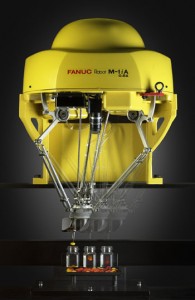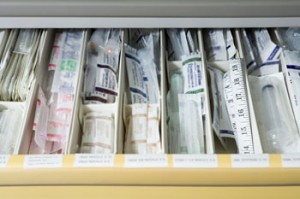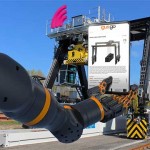FANUC robots flex to medical blister filling needs
 Compactness and dexterity were two important features of the anthropomorphic FANUC LR Mate 200iD robot selected by FlexLink for a cutting-edge medical assembly line located in Italy. Combined with a FANUC M-1iA delta robot and an integrated iRVision system, FlexLink completely re-engineered the blister packing operation, automating an intricate and time-intensive job that previously performed manually.
Compactness and dexterity were two important features of the anthropomorphic FANUC LR Mate 200iD robot selected by FlexLink for a cutting-edge medical assembly line located in Italy. Combined with a FANUC M-1iA delta robot and an integrated iRVision system, FlexLink completely re-engineered the blister packing operation, automating an intricate and time-intensive job that previously performed manually.
Pictured right: the M-1iA delta robot is designed to deliver accurate movements and handling of small objects at high speeds.
Increasing productivity enables the FlexLink system to consistently produce 60 blister packs per minute, the M-1iA delta robot starts by undertaking the first selection task. With a work diameter of 280mm, this specific model was designed by FANUC to deliver accurate movements and handling of small objects at high speeds, so suits the application perfectly.
Presented in bulk quantities on the conveyor belt, the delta robot picks up and using FANUC iRVision, quality checks each product component. “Integrating the visual system eliminates the need to orientate objects as the robot finds them,” explains FlexLink’s engineering manager Davide Zuffa. “It meant we didn’t need further conveyors and devices that would have made the conveyor system more complex and cumbersomeImperfect pieces are rejected at this phase of the process, remaining on the conveyor to be discarded.”
With the quality inspection complete, the delta robot then places each product piece onto a middle conveyor for presentation to the blister-packing robot. This FANUC robot – the LR Mate 200iD – which undertakes the blister pack packing task was customised with a double gripper (EOAT). This enables it to handle and load two product pieces simultaneously resulting in an increased output.
 Pictured left: The LR Mate 200iD is a popular choice in the pharmaceutical industry for blister pack packing of medical supplies.
Pictured left: The LR Mate 200iD is a popular choice in the pharmaceutical industry for blister pack packing of medical supplies.
But the unique positioning of the medical pieces means that they can’t simply be loaded into the blister packs and sealed. Instead, the robot is programmed to carefully manipulate and fold each medical device before delicately pushing into the blister pack. At this stage the vision system checks for correct insertion of the assembled medical device to ensure it is seated correctly within the blister pack. This guarantees a good seal and eliminates any rework.
Operating uninterrupted for three working shifts a day for some time now, this fully connective medical device assembly line has been highly praised by the end customer, reports Davide. “The system not only hosts two robots to better exploit the available space, but also achieves excellent performance levels in terms of speed and precision.
“What’s more, should the product change in the future, the flexible nature of FANUC Robots enables the design change to be easily managed and implemented. This ensures longevity of the engineering solution and better ROI on capital equipment investment. Through our work with FANUC we have created a flexible blister loading system with universal market appeal.”
Visit the FANUC website for more information.
See all stories for FANUC















